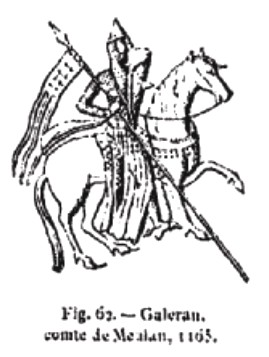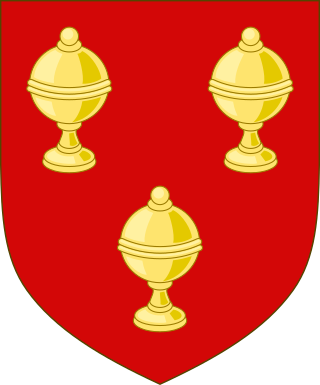Related Research Articles

John Beaufort, 1st Marquess of Somerset and 1st Marquess of Dorset, later only 1st Earl of Somerset, was an English nobleman and politician. He was the first of the four illegitimate children of John of Gaunt (1340–1399) by his mistress Katherine Swynford, whom he later married in 1396.

Thomas Beaufort, Duke of Exeter was an English military commander during the Hundred Years' War, and briefly Chancellor of England. He was the third of the four children born to John of Gaunt, Duke of Lancaster, and his mistress Katherine Swynford. To overcome their problematic parentage, his parents were married in 1396, and he and his siblings were legitimated in 1390 and again in 1397. He married the daughter of Sir Thomas Neville of Hornby, Margaret Neville, who bore him one son, Henry Beaufort. However, the child died young.
Duke of Newcastle upon Tyne was a title that was created three times, once in the Peerage of England and twice in the Peerage of Great Britain. The first grant of the title was made in 1665 to William Cavendish, 1st Marquess of Newcastle upon Tyne. He was a prominent Royalist commander during the Civil War.

Edmund Beaufort, styled 4th Duke of Somerset, 6th Earl of Somerset, 3rd Marquess of Dorset, 3rd Earl of Dorset, was an English nobleman, and a military commander during the Wars of the Roses, in which he supported the Lancastrian king Henry VI.

Duke of Somerset, from the county of Somerset, is a title that has been created five times in the peerage of England. It is particularly associated with two families: the Beauforts, who held the title from the creation of 1448, and the Seymours, from the creation of 1547, in whose name the title is still held. The present dukedom is unique, in that the first holder of the title created it for himself in his capacity of Lord Protector of the Kingdom of England, using a power granted in the will of his nephew King Edward VI.

Duke of Richmond is a title in the Peerage of England that has been created four times in British history. It has been held by members of the royal Tudor and Stuart families.
The title Duke of Exeter was created several times in England in the later Middle Ages. Exeter is the main town of Devon. It was first created for John Holland, the half-brother of King Richard II in 1397. That title was rescinded upon Henry IV's accession to the throne two years later. The title was then granted to the former's half-brother, Thomas Beaufort, 1st Earl of Dorset by his nephew Henry V. Following Beaufort's death without heirs in 1426, the title was restored to the Holland family, which held it until the 3rd Duke was attainted in 1461 as a Lancastrian, dying in 1475.

Earl of Nottingham is a title that has been created seven times in the Peerage of England. It was first created for John de Mowbray in 1377, at the coronation of Richard II. As this creation could only pass to his legitimate heirs, it went extinct on his death in 1383. It was re-created for his younger brother Thomas de Mowbray in the same year, however. This branch of the family became Dukes of Norfolk, and the title would descend with them until John de Mowbray died without male heirs in 1476.

Earl of March is a title that has been created several times in the Peerage of Scotland and the Peerage of England. The title derived from the "marches" or borderlands between England and either Wales or Scotland, and it was held by several great feudal families which owned lands in those districts. Later, however, the title came to be granted as an honorary dignity, and ceased to carry any associated power in the marches.
Baron Herbert is a title in the Peerage of England. It was created by writ in 1461 for William Herbert, who was later made Earl of Pembroke. The second Earl of Pembroke surrendered his earldom in return for the earldom of Huntingdon, which became extinct on his death without male issue. The barony, however, passed to his daughter Elizabeth, who later married the first Earl of Worcester. At Elizabeth's death, the title passed to her son, who later inherited his father's earldom of Worcester. Later, the fifth Earl was made Marquess of Worcester, and the third Marquess became Duke of Beaufort. Thereafter, the barony and dukedom remained united until 1984 when, upon the death of the tenth Duke without issue, the barony fell into abeyance. Then, in 2002, Queen Elizabeth II terminated the abeyance of the barony of Herbert in favour of the last holder's great-nephew, David John Seyfried.

Earl of Worcester is a title that has been created five times in the Peerage of England. Worcester is a cathedral city in Worcestershire, England.

The peerage title Earl of Ormond and the related titles Duke of Ormonde and Marquess of Ormonde have a long and complex history. An earldom of Ormond has been created three times in the Peerage of Ireland.

Earl of Londonderry is a title that has been created three times in the Peerage of Ireland. The first creation came in 1622 in favour of Thomas Ridgeway, 1st Baron Ridgeway, who served as Treasurer of Ireland and was involved in the colonisation of Ulster. He had already been created a Baronet, of Torrington in the County of Devon, in 1611, Lord Ridgeway, Baron of Gallen-Ridgeway, in the Peerage of Ireland, in 1616, and was made Viscount Gallen-Ridgeway at the same time as he was granted the earldom, also in the Peerage of Ireland. The titles became extinct on the death of his great-grandson, the fourth Earl, in 1714.
The title Marquess of Dorset has been created three times in the Peerage of England. It was first created in 1397 for John Beaufort, 1st Earl of Somerset, but he lost the title two years later. It was then created in 1442 for Edmund Beaufort, 1st Earl of Dorset, who was created Duke of Somerset in 1448. That creation was attainted in 1463.

Duke of Dorset was a title in the Peerage of Great Britain. It was created in 1720 for the politician Lionel Sackville, 7th Earl of Dorset.

Earl of Bridgewater was a title that has been created twice in the Peerage of England, once for the Daubeny family (1538) and once for the Egerton family (1617). From 1720 to 1803, the Earls of Bridgewater also held the title of Duke of Bridgewater. The 3rd Duke of Bridgewater is famously known as the "Canal Duke", for his creation of a series of canals in North West England.
Viscount Windsor is a title that has been created twice.

Earl of Marlborough is a title that has been created twice, both times in the Peerage of England. The first time in 1626 in favour of James Ley, 1st Baron Ley and the second in 1689 for John Churchill, 1st Baron Churchill the future Duke of Marlborough.

The House of Beaufort is an English noble and quasi-royal family, which originated in the fourteenth century as the legitimated issue of John of Gaunt, 1st Duke of Lancaster, whose eldest legitimate son was King Henry IV, the first Lancastrian king. The Beauforts played an important role during the Wars of the Roses in the fifteenth century and the eventual heiress of the family Lady Margaret Beaufort was the mother of King Henry VII, the first Tudor monarch of England.

Edmund Beaufort, 2nd Duke of Somerset, 4th Earl of Somerset, 1st Earl of Dorset, 1st Marquess of Dorset styled 1st Count of Mortain, KG, was an English nobleman and an important figure during the Hundred Years' War. His rivalry with Richard, Duke of York, was a leading cause of the Wars of the Roses.
References
- 1 2 3 Chisholm 1911, p. 431.
- This article incorporates text from a publication now in the public domain : Chisholm, Hugh, ed. (1911). "Dorset, Earls, Marquesses and Dukes of". Encyclopædia Britannica . Vol. 8 (11th ed.). Cambridge University Press. pp. 431–434.
- Leigh Rayment's Peerage Pages [ self-published source ][ better source needed ]